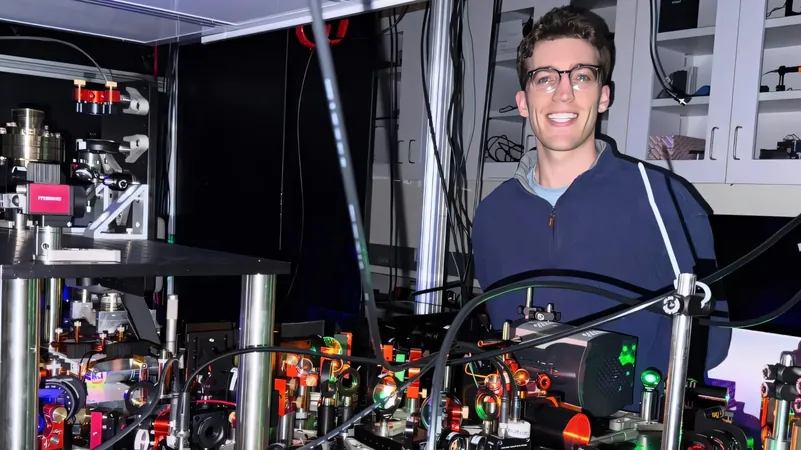
Unveiling the Future: How Single Atoms Are Set to Revolutionize Quantum Technologies
2025-06-26
Author: John Tan
In the dimly lit laboratory of Professor Sebastian Will, blink and you might just overlook them—tiny flashes illuminating screens like stars in the night sky. Each flicker represents a single atom of strontium, held captive by cutting-edge laser 'tweezers' that offer a glimpse into a world where quantum technologies are not just theoretical but tangible.
Graduate student Aaron Holman expresses the thrill of the experience: "We can see single atoms, and the excitement of witnessing that never fades away." The lab achieved this remarkable feat at the end of 2022 after two years of dedicated construction, crafting a complex setup of atomic sources, vacuum chambers, magnets, and lasers designed for trapping and arranging individual atoms.
The Ambitious "TweeSr" Project: Bridging Theory and Application
Now a fifth-year Ph.D. candidate in Physics, Holman played an essential role in establishing the "TweeSr" project, where pure atomic, molecular, and optical (AMO) physics meets groundbreaking technology. Currently collaborating with Columbia Engineering, he is committed to translating theoretical research on atoms and light into practical applications. One key endeavor involves connecting this fundamental research to a larger quantum network called SCY-QNet—an ambitious project aimed at extending from Brookhaven National Laboratory through Manhattan to Yale University.
From Curiosity to Creation: A Passion for AMO Physics
Holman's journey into the world of AMO physics began at the University of Chicago, where he double-majored in molecular engineering and physics. His early studies centered around quantum networks and materials infused with rare-earth ions for telecommunications. However, his decision to dive deeper into atomic work during graduate school has unlocked a pristine realm of possibilities, where the systems can be meticulously designed to fit precise requirements.
Revolutionizing Atomic Manipulation with Holographic Metasurfaces
The "TweeSr" project cleverly combines the concept of optical tweezers with strontium atoms. Utilizing an intense green laser, Holman and his team can trap atoms with astonishing precision. Collaborations with Professor Nanfang Yu's lab have brought into play cutting-edge holographic metasurfaces, allowing them to create multiple tweezers from a single beam of laser light, arranging them in various configurations with unparalleled accuracy.
Unlocking New Physics and Quantum Memory Potential
This groundbreaking method enables researchers to modify light interaction with closely-packed single atoms, thus revealing new phenomena such as superradiance and subradiance. These behaviors could significantly enhance quantum processing bandwidth and pave the way for advanced forms of quantum memory—both essential components for a future quantum network.
Joining Forces for a Quantum Revolution
"Yes, the TweeSrs will be integral to New York's quantum network," Holman confirms. The envisioned network requires a seamless flow of quantum information between processing units scattered across several institutions. At Columbia, their atoms will both send and receive photons, balancing the dual tasks of processing and networking at the elusive single-photon level.
The Quantum Network: More Than Just Bits
What sets this network apart? Unlike classical bits that operate in binary, quantum bits (qubits) possess extraordinary properties such as superposition and entanglement. As researchers navigate the intricate challenge of constructing a quantum network, Holman underscores the importance of collaboration across disciplines. This interdisciplinary approach not only enriches their understanding but also bridges gaps that could hinder the integration of various technologies.
The Interdisciplinary Advantage: Creating a Unified Future
Holman revels in the learning outcomes from these collaborations, emphasizing that they challenge him to think outside the confines of traditional AMO physics. By integrating insights from optical engineering and other fields, the lab aims to cultivate innovations that will lead to a cohesive technological future. In a rapidly advancing world, it's crucial that we foster interconnectedness among technologies, ensuring that advancements today will work harmoniously tomorrow.



 Brasil (PT)
Brasil (PT)
 Canada (EN)
Canada (EN)
 Chile (ES)
Chile (ES)
 Česko (CS)
Česko (CS)
 대한민국 (KO)
대한민국 (KO)
 España (ES)
España (ES)
 France (FR)
France (FR)
 Hong Kong (EN)
Hong Kong (EN)
 Italia (IT)
Italia (IT)
 日本 (JA)
日本 (JA)
 Magyarország (HU)
Magyarország (HU)
 Norge (NO)
Norge (NO)
 Polska (PL)
Polska (PL)
 Schweiz (DE)
Schweiz (DE)
 Singapore (EN)
Singapore (EN)
 Sverige (SV)
Sverige (SV)
 Suomi (FI)
Suomi (FI)
 Türkiye (TR)
Türkiye (TR)
 الإمارات العربية المتحدة (AR)
الإمارات العربية المتحدة (AR)